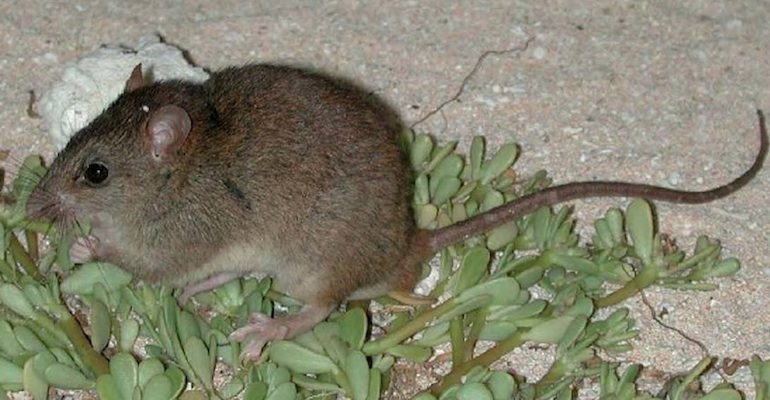 This summer, the Bramble Cay melomys, a reddish-brown rodent that resembles a large mouse, made international news. In mid-June, the Guardian reported that the melomys, last seen in 2009, had been confirmed extinct in its only known habitat, a tiny, isolated coral outcrop in the narrow strait between Australia and New Guinea. “First mammal species wiped out by human-induced climate change,” the headline read. The story, and the declaration, were picked up by publications around the world.
This summer, the Bramble Cay melomys, a reddish-brown rodent that resembles a large mouse, made international news. In mid-June, the Guardian reported that the melomys, last seen in 2009, had been confirmed extinct in its only known habitat, a tiny, isolated coral outcrop in the narrow strait between Australia and New Guinea. “First mammal species wiped out by human-induced climate change,” the headline read. The story, and the declaration, were picked up by publications around the world.
Climate change certainly dealt a blow to the melomys, and very likely the fatal blow. In 1998, about ten acres of Bramble Cay lay above the high tide line; by 2014, only six acres remained above the tide, and rising seas had flooded the entire island several times, killing or damaging most of the succulent plants the species depended on for food. The melomys was last seen alive in 2009, and this past June, a report by three scientists to the Australia’s Department of Environment and Heritage Protection concluded that there were no more melomys on Bramble Cay. The last remaining members of the species may have been simply washed away.
But did climate change kill the melomys? Yes and no.
Two weeks after its initial story, the Guardian reported that Australian researchers had intended to bring a few melomys back to the mainland to start a captive breeding program. But when their surveys of Bramble Cay failed to turn up a single individual, their rescue mission ended with an obituary. “My colleagues and I were devastated,” the expedition leader told the Guardian.
That missed opportunity, says biologist John Woinarski, was the last act in a tragedy that had been unfolding for years, often in plain sight. In a new paper in Conservation Biology, Woinarski and three colleagues conduct what might be called an inquest into three recent Australian extinctions: the Christmas Island pipistrelle (a small bat), the Christmas Island forest skink (a plain brown lizard), and the melomys. All three extinctions, the authors conclude, “were predictable and most likely could have been prevented.”
The pipistrelle was common on Christmas Island until the mid-1980s, but in the mid-1990s its numbers began to decline, and dropped quickly and steadily until the species went extinct in 2009. The skink started to decline at around the same time, and its last representative, nicknamed Gump, died in captivity in 2014. Both species are thought to have been done in by introduced predators, probably the giant centipede and the common wolf snake.
Woinarski argues that the centipede and the snake, much like the rising tides on Bramble Cay, were enabled for years by human neglect and inaction. Australia’s biodiversity conservation law makes no explicit commitment to preventing human-caused extinctions, so species threatened by diffuse or complex threats are often left unprotected, and the protection measures that do exist are frequently inadequate; though researchers began to document the skink’s decline in 1999, it was not officially recognized as critically endangered until 2014, four months before its extinction. The pipistrelle, like the melomys, suffered from a delayed rescue attempt: its plight was recognized in the late 1990s, but by the time the government approved a captive breeding program, in 2009, there was only one bat left — and that bat, understandably, refused to be caught.
These three species were also particularly easy to ignore: they’re small and unremarkable, and they live in some of the most remote places on the planet. They don’t play an obviously important role in their ecosystems, or occupy a unique place in evolutionary history; they’re not beloved by any particular human community or culture. Only their extinction makes them distinctive, and even that is less and less unusual: Australia has the highest rate of mammal extinctions in the world, with thirty species, including the melomys, lost in the two hundred and thirty years since European colonization.
Woinarski, who lived on Christmas Island just after the extinction of the pipistrelle and during the extinction of the skink, was also part of the recovery planning process for the melomys. His extinction assessment, he says, was motivated by personal grief, and by a desire to understand what could be done differently next time. For there will be a next time: Though recent reforms have strengthened its national conservation policy, Australia and its outlying islands have nearly two thousand threatened and endangered species. Those already close to extinction include the Christmas Island shrew, the only shrew in Australia; the Western ground parrot, a shy, bright-green bird that lives on the southwestern coast; and the bridled nailtail wallaby or flashjack, a favorite prey of cats, dogs, and foxes.
To say that climate change killed the Bramble Cay melomys, says Woinarski, is “accurate but shallow.” It ignores the many other environmental factors that probably led to its extinction, and it obscures the fact that humans could have saved the species — not only by slowing climate change in the first place, but also by rescuing the species from its effects. People, he emphasizes, could have prevented the extinction of the melomys. They chose not to.
Photo of the Bramble Cay melomys from Wikimedia Commons.